Bring your class to the Connecticut Museum of Culture and History for an engaging field trip! Museum programs are thematic and focus on a wide range of social studies topics from Connecticut history to civics and geography. Programs take place in the Museum’s permanent and changing exhibitions, or in other non-exhibit spaces at the Museum.
Group Limit: Program dependent
Length: 1 ½ hours
Cost: $10 per student, discounts available for Priority School Districts and Title I Schools
Thank you to the Charles D. Fleischman Charitable Trust, the Society of the Cincinnati in the State of Connecticut, and the U.S. Department of Education.

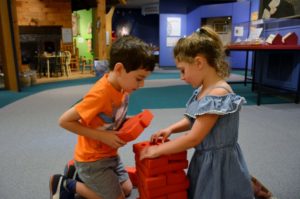 In this museum tour for our youngest visitors, students will explore how communities past and present have provided for their needs. Students will compare work done long ago to work today by trying out different "jobs" related to building, making clothes, and preparing food. After their "work" is done, students play with reproduction historic toys.
In this museum tour for our youngest visitors, students will explore how communities past and present have provided for their needs. Students will compare work done long ago to work today by trying out different "jobs" related to building, making clothes, and preparing food. After their "work" is done, students play with reproduction historic toys.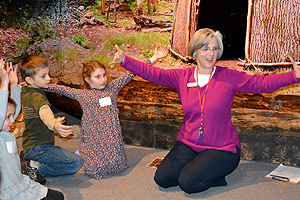 This program introduces students to the lives of Native communities from our region, with a focus on the relationships between the local environment and local Native cultures. Through multi-sensory learning and handling reproduction artifacts, students will explore characteristics of pre-colonization Native communities, including foodways, homes, and technologies. Students will listen to a local Native story and learn how oral histories carry on a community's culture.
This program introduces students to the lives of Native communities from our region, with a focus on the relationships between the local environment and local Native cultures. Through multi-sensory learning and handling reproduction artifacts, students will explore characteristics of pre-colonization Native communities, including foodways, homes, and technologies. Students will listen to a local Native story and learn how oral histories carry on a community's culture.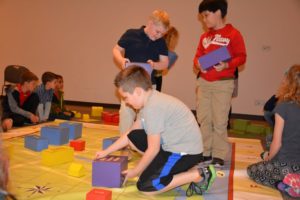 Students use a large floor map and “building” blocks to strengthen map skills and vocabulary while creating and analyzing a new town, then use our exhibit space to explore how community life differed in the past. The third part of the program focuses on how decisions are made in communities, as well as ways that children can be good citizens and contribute to their communities.
Students use a large floor map and “building” blocks to strengthen map skills and vocabulary while creating and analyzing a new town, then use our exhibit space to explore how community life differed in the past. The third part of the program focuses on how decisions are made in communities, as well as ways that children can be good citizens and contribute to their communities.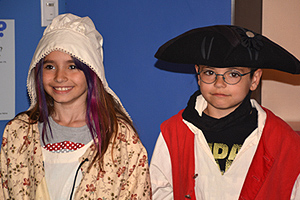 What was it like to be an English
What was it like to be an English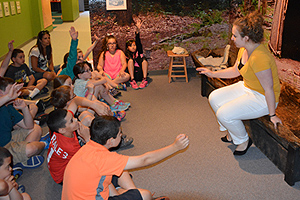 Explore culture and change in the region we now call Connecticut by looking at the lives of the Native Peoples that live here. By listening to a local Native story, analyzing maps, and examining historical artifacts, students will learn about how Native Peoples have shaped the land and the communities that make up the Connecticut we know today.
Explore culture and change in the region we now call Connecticut by looking at the lives of the Native Peoples that live here. By listening to a local Native story, analyzing maps, and examining historical artifacts, students will learn about how Native Peoples have shaped the land and the communities that make up the Connecticut we know today.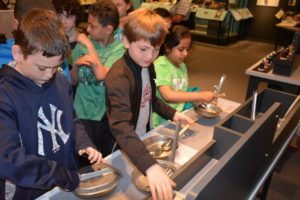 What makes our state so special? During this thematic tour students will learn about famous Connecticut people, places, events, and products. From the mighty white oak to the tiny nutmeg, “Constitution State” to famous (and not-so-famous) Connecticut innovations and people, students explore the unique stories behind our state’s history and symbols.
What makes our state so special? During this thematic tour students will learn about famous Connecticut people, places, events, and products. From the mighty white oak to the tiny nutmeg, “Constitution State” to famous (and not-so-famous) Connecticut innovations and people, students explore the unique stories behind our state’s history and symbols.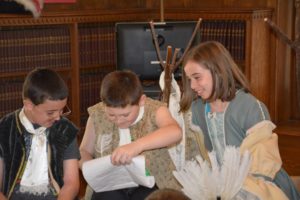 Why is the white oak a symbol of Connecticut’s strength and independence? During this program, students bring the people and events from the legend of the Charter Oak to life using a variety of dramatic techniques, period costumes, and specially-designed props. Students evaluate sources, including historic maps, to draw their own conclusions about the famous legend.
Why is the white oak a symbol of Connecticut’s strength and independence? During this program, students bring the people and events from the legend of the Charter Oak to life using a variety of dramatic techniques, period costumes, and specially-designed props. Students evaluate sources, including historic maps, to draw their own conclusions about the famous legend.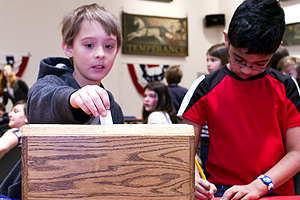 In this program, students explore Connecticut’s executive, legislative, and judicial branches of government to discover who makes the rules in Connecticut. To better understand the role of each branch, students elect a governor from among their classmates, debate a bill, and hold a mock trial (student reading required). Through role-playing and active participation, students learn the purpose of rules and laws, explore the separation of powers, and discover the rights and responsibilities of individuals.
In this program, students explore Connecticut’s executive, legislative, and judicial branches of government to discover who makes the rules in Connecticut. To better understand the role of each branch, students elect a governor from among their classmates, debate a bill, and hold a mock trial (student reading required). Through role-playing and active participation, students learn the purpose of rules and laws, explore the separation of powers, and discover the rights and responsibilities of individuals.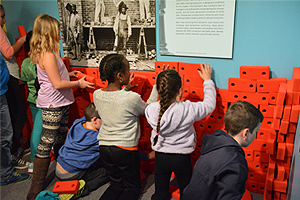 This program uses hands-on activities to introduce students to stories of moving to Connecticut. During the workshop, students work in teams to examine artifacts and documents from “immigration trunks” and uncover different family stories about moving to Connecticut from Ireland, Germany, China, Georgia, and Puerto Rico. In the Making Connecticut exhibit, students try out the kinds of jobs done by different immigrant groups who arrived in Connecticut in the 19th and 20th centuries.
This program uses hands-on activities to introduce students to stories of moving to Connecticut. During the workshop, students work in teams to examine artifacts and documents from “immigration trunks” and uncover different family stories about moving to Connecticut from Ireland, Germany, China, Georgia, and Puerto Rico. In the Making Connecticut exhibit, students try out the kinds of jobs done by different immigrant groups who arrived in Connecticut in the 19th and 20th centuries.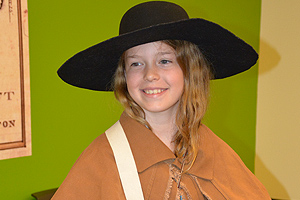 Students will investigate how the American Revolution impacted Connecticut residents by exploring the war through a variety of perspectives. What led Connecticans to become Patriots or Loyalists? How was the war different for those on the battlefield than for those on the homefront? What did America's War for Independence mean for Connecticut's enslaved and Native residents? Students will explore these experiences through museum exhibitions, primary sources, reproduction artifacts, and hands-on activities (including signing an 'Oath of Allegiance' with a quill pen and ink).
Students will investigate how the American Revolution impacted Connecticut residents by exploring the war through a variety of perspectives. What led Connecticans to become Patriots or Loyalists? How was the war different for those on the battlefield than for those on the homefront? What did America's War for Independence mean for Connecticut's enslaved and Native residents? Students will explore these experiences through museum exhibitions, primary sources, reproduction artifacts, and hands-on activities (including signing an 'Oath of Allegiance' with a quill pen and ink).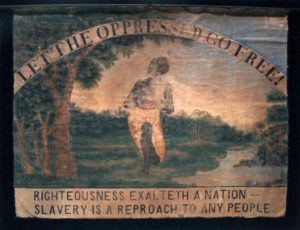 Students
Students 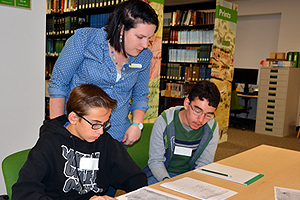 Bring your students to the Museum for a class and a tour! A museum educator will teach a 45-minute Black and Latino Studies lesson of your choosing (select from one of our ten digital resource packs), followed by a tour of our exhibitions.
Bring your students to the Museum for a class and a tour! A museum educator will teach a 45-minute Black and Latino Studies lesson of your choosing (select from one of our ten digital resource packs), followed by a tour of our exhibitions.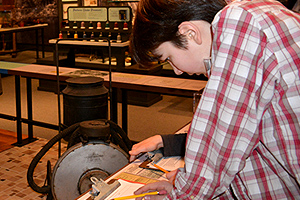 Length: 30 Minutes
Length: 30 Minutes Length: 30 Minutes
Length: 30 Minutes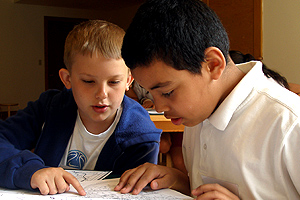 Length: 30 Minutes
Length: 30 Minutes